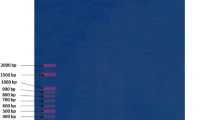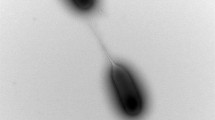Abstract
The isolate Pseudomonas aeruginosa exhibited resistance to heavy metals such as cadmium, chromium, nickel and lead. Plasmid DNA was isolated from P. aeruginosa and designated as pBC15. The size of the plasmid DNA was approximately 23 kb. Escherichia coli DH5α was transformed with plasmid pBC15 subsequired resistance to nickel and ampicillin. The same size of the plasmid was isolated from E. coli transformant and separated on 0.7 % agarose gel electrophoresis. The restriction analysis of pBC15 showed that the plasmid DNA has single site for Bam HI and Eco RI and three sites for Xho I which were compared with 1 Kb DNA and λ Hind III digest molecular markers. Therefore, the size of the plasmid DNA of pBC15 was confirmed to be 23 kb. Curing was carried out by ethidium bromide, acridine orange, novobiocin, sodium dodechyl sulphate and elevated temperature (40 °C). Transformation and curing results suggest that nickel and ampicillin resistance gene was conferred by plasmid DNA. Cadmium resistant gene was present on chromosomal DNA along with the gene for chromium resistance. Lead resistance gene was shown to be present on the chromosomal DNA rather than the plasmid DNA as the cured and uncured cultures remained similar in lead resistance. Therefore, the ability of P. aeruginosa resistant to nickel and ampicillin is plasmid mediated and transferable to other strains whereas cadmium, chromium and lead could be chromosomal encoded. The heavy metal and antibiotic resistances of P. aeruginosa can be used to exploit for clean up industrial wastewater and bioremediation of heavy metal contaminated soil.
Similar content being viewed by others
References
Ajmal, M.; Mohammad, A.; Yousuf, R.; Ahmad, A., (1998). Adsorption behaviour of cadmium, zinc, nickel and lead from aqueous solution by Mangifera indica seed shell. Indian J. Environ. Health., 40(1), 5–26 (22 pages).
Asmatullah, Q. S. N.; Shakoori, A. R., (1998). Hexavalent chromium-induced congenital abnormalities in chick embryos. J. Appl. Toxicol., 18(3), 167–171 (5 pages).
Babich, H.; Stotzky, G., (1983). Toxicity of nickel to microbes: Environmental aspects. Adv. Appl. Microbiol., 29(1), 195–265 (71 pages).
Banjerdkij, P.; Vattanaviboon, P.; Mongkolsuk, S., (2005). Exposure to cadmium elevates expression of genes in the oxy R and Ohr R regulons and induces cross-resistance to peroxide killing treatment in Xanthomonas campestris. Appl. Environ. Microbiol., 71(4), 1843–1849 (7 pages).
Bauer, A. W.; Kirby, W. M. M.; Sherris, J. C.; Turck, M., (1966). Antibiotic susceptibility testing by a standardized single disc method. Am. J. Clin. Pathol., 45(4), 493–496 (7 pages).
Bogdanova, E. S.; Bass, I. A.; Minakhin, L. S.; Petrova, M. A.; Mindin, S. Z.; Volodin, A. A.; Kalyaeva, E. S.; Tiedje, G. M.; Hobman, J. L.; Brown, N. L.; Nikiforov, V. G., (1998). Transfer of mer operons amongest environmental isolates of gram-positive bacteria. Microbiology, 144(3), 609–620 (12 pages).
Bolshakova, A. V.; Kiselyova, O. I.; Filonov, A. S.; Frolova, O.; Yu Lyubchenko Yu, L.; Yaminsky, I. V., (2001). Comparative analysis of bacteria with atomic force microscopy operating in different modes. Ultra Microscopy, 68(1–2), 121–128 (8 pages).
Bruins, M. R.; Kapil, S.; Oehme, F. W., (2003). Characterization of a small plasmid (pMBCP) from bovine Pseudomonas pickettii that confers cadmium resistance. Ecotox. Environ. Safe., 54(3), 241–248 (8 pages).
Cervantes, C.; Silver, S., (1996). Metal resistance systems in Pseudomonas. Rev. Latin. Microbiol., 38(1), 45–64 (20 pages).
Chakrabarty, A. M., (1976). Plasmids in Pseudomonas. Annu. Rev. Gen., 10, 7–30 (24 pages).
Chen, C. Y.; Lin, T. H., (1998). Nickel toxicity to human term placenta: In vitro study on lipid per oxidation. J. Toxicol. Env. Health., Part A, 54(1), 37–47 (11 pages).
Collard, J. M.; Corbisier, P.; Diels, L.; Dong, Q.; Jeanthon, C.; Mergeay, M.; Taghavi, S.; Vander Lelie, D.; Wilmotte, A.; Wuertz, S., (1994). Plasmids for heavy metal resistance in Alcaligenes eutrophus CH34: Mechanism and applications. FEMS Microbiol. Rev., 14(4), 405–414 (10 pages).
Ebdon, L.; Pitts, I.; Cornelis, R.; Crews, H.; Donard, O. F. X.; Quevauviller, P., (2001). Trace element speciation for environment, food and health. Cambridge UK: Royal society of chemistry, ISBN 0854044590.
Edward Raja, C.; Anbazhagan, K.; Selvam, G. S., (2006). Isolation and characterization of a metal-resistant Pseudomonas aeruginosa strain. World J. Microbiol. Biotechnol., 22(6), 577–585 (9 pages).
Haq, R.; Zaidi, S. K.; Shakoori, A. R., (1999). Cadmium resistant Enterobacter cloacae and Klebsiella sp. isolated from industrial effluents and their possible role in cadmium detoxification. World J. Microbiol. Biotech., 15(2), 249–254 (6 pages).
Jin, Y. A.; Clark, A. B.; Slebos, R. J.; AL-Refai, H.; Taylor, J. A.; Kunkel, T. A.; Resnick, M. A.; Gordenin, D. A., (2003). Cadmium is a mutagen that acts by inhibiting mismatch repair. Nat. Genet., 34(3), 239–241 (3 pages).
Kassab, D. M.; Roane, T. M., (2006). Differential responses of a mine tailings Pseudomonas isolate to cadmium and lead exposures. Biodegradation, 17(4), 379–387 (9 pages).
Low, K. S.; Lee, C. K.; Liew, S. C., (2000). Sorption of Cadmium and Lead form aqueous solution by spent grain. Proc. Biochem., 36(1–2), 59–64 (6 pages).
Mesas, J. M.; Carmen-Rodriguez, M.; Teresa Alegrec, T. M., (2004). Plasmid curing of Oenococcus oeni. Plasmid, 51(1), 37–40 (4 pages).
Mulrooney, S. B.; Hausinger, R. P., (2003). Nickel uptake and utilization by microorganisms. FEMS Microbiol. Rev., 27(2–3), 239–261 (23 pages).
Nies, D. H., (2003). Efflux mediated heavy metal resistance in prokaryotes. FEMS Microbiol. Rev. 27(2–3), 313–339 (27 pages).
Park, S. M.; Kim, S. H.; Yu, T. S., (2006). Effect of titanium ion and resistance encoding plasmid of Pseudomonas aeruginosa ATCC 10145. J. Microbiol., 44(3), 255–262 (8 pages).
Prasad, M. N. V.; Strazalka, K., (2000). In: Physiology and biochemistry of metal toxicity and tolerance in plants, Kluwer Academic Publishers, Boston, 153–160.
Prasenjit, B.; Sumathi, S., (2005). Uptake of chromium by Aspergillus foetidus. J. Mat. Cyc. Waste Manage., 7(2), 88–92 (5 pages).
Ramteke, P. W., (1997). Plasmid mediated co-transfer of antibiotic resistance and heavy metal tolerance in coli forms. Indian J. Microbiol., 37, 177–181 (5 pages).
Rensing, C.; Sun, Y.; Mitra, B.; Rosen, B. P., (1998). Pb (II) translocating P-type ATPases. J. Biol. Chem., 273(49), 32614–32617 (4 pages).
Roane, T. M.; Kellogg, S. T., (1996). Characterization of bacterial communities in heavy metal contaminated soils. Can. J. Microbiol., 42(6), 593–603 (11 pages).
Romling, U.; Wingender, T.; Muller, H.; Tummler, B., (1994). A major Pseudomonas aeruginosa clone common to patients and aquatic habitats. Appl. Environ. Microbiol., 60(6), 1734–1738 (5 pages).
Rosas, S. B.; Calzolari, A.; La Torre, J. L.; Ghittoni, N. E.; Vasquez, C., (1983). Involvement of a plasmid in Escherichia coli envelope alterations. J. Bacteriol., 155(1), 402–406 (5 pages).
Rossello-Mera, A. R.; Lalucat, J.; Garcia-Valdes, E., (1994). Comparative biochemical and genetic analysis of naphthalene degradation among Pseudomonas stutzeri strains. Appl. Environ. Microbiol., 60(3), 966–972 (7 pages).
Saha, S.; Singh, R. P.; Verma, J. P.; Jayaraman, J., (2001). Plasmid-borne determinants of colony morphology, pigmentation, antibiotic resistance and antibiosis in Pseudomonas species antagonistic to bacterial blight of cotton. Curr. Sci., 79(9), 1384–1385 (2 pages).
Sambrook, J.; Fritsch, E. F.; Maniatis, T., (1989). Molecular cloning: A laboratory manual, 2nd. Ed. Cold spring harbour, NY: Cold spring harbour laboratory press.
Shumilla, A. J.; Broderick, J. R.; Wang, Y.; Barchowsky, A., (1999). Chromium Cr (VI) inhibits the transcriptional activity of nuclear factor-B by decreasing the interaction of p65 with cAMP-responsive element binding protein. J. Biol. Chem., 274(51), 36207–36212 (6 pages).
Unaldi, M. N.; Korkmaz, H.; Ankan, B.; Corel, G., (2003). Plasmid-encoded heavy metal resistance in Pseudomonas sp. Bull. Environ. Contam. Toxicol., 71(6), 1145–1150 (6 pages).
Author information
Authors and Affiliations
Corresponding author
Rights and permissions
About this article
Cite this article
Raja, C.E., Selvam, G.S. Plasmid profile and curing analysis of Pseudomonas aeruginosa as metal resistant. Int. J. Environ. Sci. Technol. 6, 259–266 (2009). https://doi.org/10.1007/BF03327630
Received:
Revised:
Accepted:
Published:
Issue Date:
DOI: https://doi.org/10.1007/BF03327630




